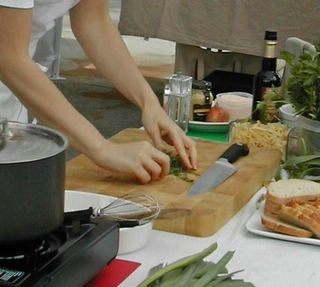Sunday, August 22, 2004
Owning a restaurant
People ask me if I would open a restaurant. I always answer (emphatically) no. For one thing I love meeting people the way I do, getting to give personal service and without the enormous pressure a restaurant brings. I have thought about opening a tiny retail space to have classes, but in the end, I think that is just as stressful (with the rent I would be obliged to someone, something I don’t want.) I read a great article in the San Francisco Chronicle today that explains a little better than I can why opening is a restaurant is so tough. Its super long, so here are some excerpts. For the full story go to
http://www.sfgate.com/cgi-bin/article.cgi?f=/c/a/2004/08/22/BUGCL8BS221.DTL
"A love of food and beverage is not enough," said Hudson Riehle, a spokesman at the National Restaurant Association in Washington. "A restaurant operator has to focus on managing the expenses side of the equation."
Consider Gayle Pirie, 40, and John Clark, 44, the husband-and-wife chef team who revitalized Mission District restaurant Foreign Cinema when they took over the kitchen three years ago.
Although it's clear their real love is creating culinary art, they, like most modern chefs, are forced to keep an eye on the bottom line. It's a constant juggling act to provide customers with a bountiful experience while keeping close tabs on the costs of food, labor and a horde of incidentals, from the candle tax to the courtyard heaters to site repairs.
The 220-seat restaurant serves about 1,300 to 1,400 diners a week, with an average per-person check of about $40. After adding in revenues from private parties and people who just have drinks in the bar, it had 2003 sales of $3.2 million and is on track to do $4 million this year.
Foreign Cinema is cash-flow positive, but it won't realize a genuine profit for at least five years, because it carries $2 million in debt. Its earnings before interest, depreciation and amortization were $86,000 last year. With higher sales and a tight grip on operating expenses this year, they may hit $400,000.
Their food and beverage costs average about $21,000 a week, or 30 percent of their weekly revenue of $70,000.
Of every dollar a full-service restaurant brings in, it spends roughly a third on food and alcohol; another third on salaries, wages and benefits; up to 10 cents on rent; and up to 20 cents on other costs such as marketing, according to studies by restaurant associations.
That leaves about 4 cents of pretax profit. As with all restaurants, alcohol is far more profitable than food. "We pay $25 for a bottle of booze and sell it for $100," McDonald said. (Beer and wine have slightly lower markups.) "Many people who start out in the restaurant business end up owning bars or in real estate."
----------- Now you see why I think a restaurant isnt the way to go for me! :-)
<< Home
